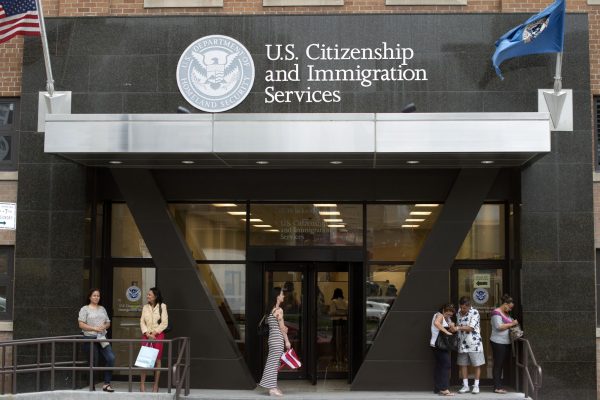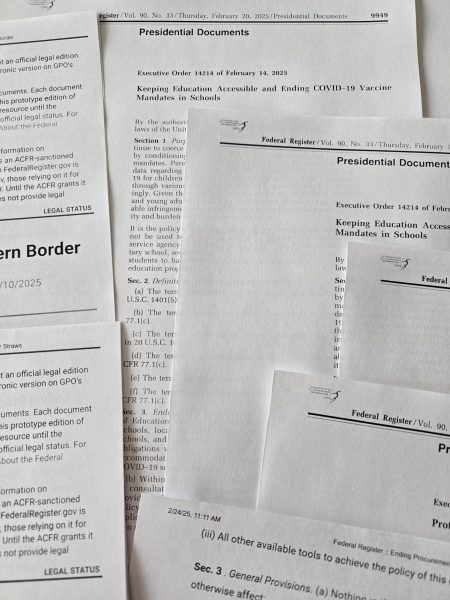Presidential candidates remain unforeseen
The republican and democratic candidates of the 2016 presidential election are still unidentifiable, as primaries head to Wisconsin.
According to the Associated Press, currently on the republican edge, Donald Trump is leading with 736 delegates, Ted Cruz has 463, and John Kasich holds the rest with 143. Trump has also won the support of 21 states, which is more than the amount Cruz, Kasich and Rubio have together.
The democratic race is down to two runners, Hillary Clinton and Bernie Sanders. While Clinton only has won a handful more states than Sanders, she does lean the delegate favor towards her with about 700 more than her opponent.
“I think Trump’s clearly leading republican primaries, and I think Clinton’s clearly leading in the democratic,” William Pelz, Ph. D, professor of history and political science, said. “But again, there’s a lot of states left.”
According to Pelz, there may no longer be a majority of states left, but there are still over a dozen in the air. Of these states, the one that may describe the future of the nomination will most likely be Wisconsin.
“Trump, if he can win Wisconsin, might be able to put away the nomination,” Pelz said. “On the other hand, it will be hard for Sanders to find a way to the nomination, if he doesn’t do very well in Wisconsin.”
Wisconsin has not always been an important step in the primary procedure as much as Iowa has.
“What’s different about this year is often, in recent years, the nominee has become apparent very early on,” Pelz said.
The primary race may be heading into a new direction that has not been seen in modern years. A clear forerunner for both parties may not appear until June 7, when California, New Jersey, Montana and the Dakotas host their primaries.
“What’s interesting about this is that the primaries [are] going so late into the season,” Pelz said. “For example, it is possible that either party, or both party’s primary, might go down to wait until June when I believe California votes around.”
Chris Newman, professor of political science, is focused on the division that may occur in the Republican Party. He connected the division of the current party’s race to a similar occurrence during the 1968 presidential election; when republicans were severed between Richard Nixon and George Wallace, who ran as independent.
“I don’t think that there’s going to be much of a split, despite some noise, in the democrats,” Newman said. “Because when it all comes down to it really, Bernie supporters will probably go along with Hillary, and vice versa.”
The amount of nominees that were originally running for the republican nomination is not usual, and caused rifts in the race.
“It’s very rare you get this big of a split,” Newman said. “The current democratic situation is much more typical, with one or two.”
A reason behind this noise may be due to the underdogs of this election, Trump and Sanders, Pelz said.
“Both Sanders and Trump came out of nowhere in terms of what people were expecting,” Pelz said. “The two anointed candidates were Clinton and Bush. This was supposed to be, and people wrote long articles about it, an election coming up between Jeb Bush and Hillary Clinton.”
According to Pelz, Hillary thought she would wrap up Sanders after Michigan. Instead, Sanders won Michigan and received 67 more delegates.
Trump has been able to perform the same ability, and become competition for the other nominees who are usually running politicians and officeholders.
“[Trump] managed to sort of come out of nowhere and establish himself as a huge strong contender,” Pelz said. “In fact, he’s the clear leader, far more than say Clinton is in the Democratic Party. Trump has been dominant in the Republican Party.”
Both Trump and Sanders have been receiving a majority of grass roots support, which has been their advantage.
“Because of all the $5 million plus small donations [Sanders has] gotten he’s managed to stay competitive, which is really quite surprising,” Pelz said. “I think both Sanders and Trump represent basically people tired with the status quo.”
According to Newman, nominees off the status quo are not unique to American history, but it is rarely seen. A similar campaign occurred with Teddy Roosevelt and the Bull Moose Party.
“We got two presidential elections that bare something similar to what we’ve got [now],” Newman said. “One is the 1912 election when Teddy Roosevelt took a walk from the Republican Convention and ran under the Progressive Party which we usually refer to as the Bull Moose Party. And Woodrow Wilson sneaked in with a majority of the Electoral College vote.”
According to Pelz, the Republican Party may be forming an Anti-Trump movement that could persuade his delegates to vote for another nominee at the Republican National Convention; if a consensus is not immediately reached.
“Jeb Bush endorsed Ted Cruz, who everybody knows he hates, just to stop Trump,” Pelz said.
The 2016 RNC will be held from July 18 to 21. The Democratic National Convention will be a week later, from July 25 to 28.





